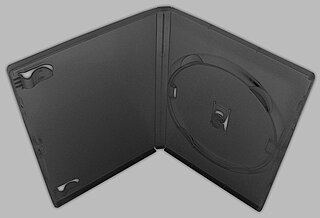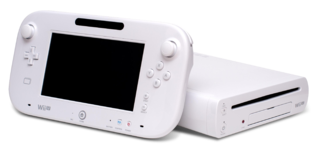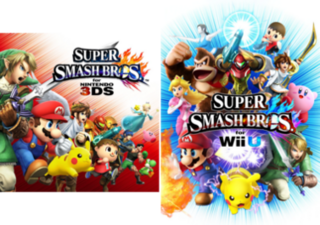
The GameCube is a home video game console developed and marketed by Nintendo. It was released in Japan on 14 September 2001, in North America on 18 November 2001, in Europe on 3 May 2002, and in Australia on 22 April 2002. It is the successor to the Nintendo 64. As a sixth-generation console, the GameCube primarily competed with the PlayStation 2 and Xbox.

In computing, an optical disc drive is a disc drive that uses laser light or electromagnetic waves within or near the visible light spectrum as part of the process of reading or writing data to or from optical discs. Some drives can only read from certain discs, but recent drives can both read and record, also called burners or writers. Compact discs, DVDs, and Blu-ray discs are common types of optical media which can be read and recorded by such drives.
A regional lockout is a class of digital rights management preventing the use of a certain product or service, such as multimedia or a hardware device, outside a certain region or territory. A regional lockout may be enforced through physical means, through technological means such as detecting the user's IP address or using an identifying code, or through unintentional means introduced by devices only supporting certain regional technologies.

The Wii is a home video game console developed and marketed by Nintendo. It was released on November 19, 2006, in North America and in December 2006 for most other regions of the world. It is Nintendo's fifth major home game console, following the GameCube and is a seventh-generation console alongside Microsoft's Xbox 360 and Sony's PlayStation 3.

MiniDVD is a DVD disc which is 8 centimetres (3.15 in) in diameter. The most common MiniDVDs are single layered, which can hold 1.46 GB of data, however, there also exists dual layered 2.6 GB versions, dual sided single layer 2.8 GB versions, and dual sided dual layer 5.2 GB versions. The MiniDVD is also known as a "3 inch DVD", referring to its approximate diameter in inches.
The history of video game consoles, both home and handheld, had their origins in the 1970s. The concept of home consoles used to play games on a television set was founded by the 1972 Magnavox Odyssey, first conceived by Ralph H. Baer in 1966. Handheld consoles bore out from electro-mechanical games that had used mechanical controls and light-emitting diodes (LED) as visual indicators. Handheld electronic games had replaced the mechanical controls with electronic and digital components, and with the introduction of Liquid-crystal display (LCD) to create video-like screens with programmable pixels, systems like the Microvision and the Game & Watch became the first handheld video game consoles, and fully realized by the Game Boy system.
Homebrew, when applied to video games, refers to games produced by hobbyists for proprietary video game consoles which are not intended to be user-programmable. The official documentation is often only available to licensed developers, and these systems may use storage formats that make distribution difficult, such as ROM cartridges or encrypted CD-ROMs. Many consoles have hardware restrictions to prevent unauthorized development.

The WaveBird Wireless Controller is a radio frequency-based wireless controller manufactured by Nintendo for use with the GameCube home video game console. Its name is a reference to Dolphin, the GameCube's codename during development. The WaveBird was available for purchase separately as well as in bundles with either Metroid Prime or Mario Party 4, which were exclusive to Kmart in the US.
Super Smash Bros. is a crossover fighting game series published by Nintendo. The series was created by Masahiro Sakurai, who has directed every game in the series. The series is known for its unique gameplay objective which differs from that of traditional fighters, in that the aim is to increase damage counters and knock opponents off the stage instead of depleting life bars.
Video game packaging refers to the physical storage of the contents of a PC or console game, both for safekeeping and shop display. In the past, a number of materials and packaging designs were used, mostly paperboard or plastic. Today, most physical game releases are shipped in (CD) jewel cases or (DVD) keep cases, with little differences between them.

A keep case or poly-box is a type of packaging, most commonly used with DVDs and Blu-ray videos.
The seventh generation of home video game consoles began on November 22, 2005, with the release of Microsoft's Xbox 360 home console. This was followed by the release of Sony's PlayStation 3 on November 17, 2006, and Nintendo's Wii on November 19, 2006. Each new console introduced new technologies. The Xbox 360 offered games rendered natively at high-definition video (HD) resolutions, the PlayStation 3 offered HD movie playback via a built-in 3D Blu-ray Disc player, and the Wii focused on integrating controllers with movement sensors as well as joysticks. Some Wii controllers could be moved about to control in-game actions, which enabled players to simulate real-world actions through movement during gameplay. By this generation, video game consoles had become an important part of the global IT infrastructure; it is estimated that video game consoles represented 25% of the world's general-purpose computational power in 2007.

The Wii system software is a discontinued set of updatable firmware versions and a software frontend on the Wii home video game console. Updates, which could be downloaded over the Internet or read from a game disc, allowed Nintendo to add additional features and software, as well as to patch security vulnerabilities used by users to load homebrew software. When a new update became available, Nintendo sent a message to the Wii Message Board of Internet-connected systems notifying them of the available update.

The GameCube controller is the standard game controller for the GameCube home video game console, manufactured by Nintendo and launched in 2001. As the successor to the Nintendo 64 controller, it is the progression of Nintendo's controller design in numerous ways. The contentious M-shaped design of its predecessor was replaced with a more conventional handlebar style controller shape; a second analog stick was added, replacing the C buttons with a C stick and the X and Y face buttons, last seen on the Super Nintendo controller, were reintroduced; the shoulder buttons were changed to hybrid analog triggers. A wireless variant of the GameCube controller known as the WaveBird was released in 2002.

The Japanese multinational consumer electronics company Nintendo has developed seven home video game consoles and multiple portable consoles for use with external media, as well as dedicated consoles and other hardware for their consoles. As of September 30, 2021, in addition to Nintendo Switch, Nintendo has sold over 863.07 million hardware units.

In computing, the burst cutting area (BCA) or narrow burst cutting area (NBCA) refers to the circular area near the center of a DVD, HD DVD or Blu-ray Disc, where a barcode can be written for additional information such as ID codes, manufacturing information, and serial numbers. The BCA can be written during mastering and will be common for all discs from that master or, more usually, will be written using a YAG laser to "cut" the barcode into the aluminum reflective layer of the finished disc, potentially adding a unique barcode to each manufactured disc.

The Wii U is a home video game console developed by Nintendo as the successor to the Wii. Released in late 2012, it is the first eighth-generation video game console and competed with Microsoft's Xbox One and Sony's PlayStation 4.

Super Smash Bros. for Nintendo 3DS and Super Smash Bros. for Wii U are 2014 crossover platform fighter video games developed by Bandai Namco Studios and Sora Ltd. and published by Nintendo for the Nintendo 3DS and Wii U video game consoles. It is the fourth installment in the Super Smash Bros. series, succeeding Super Smash Bros. Brawl. The Nintendo 3DS version was released in Japan on September 13, 2014, and in North America, Europe, and Australia the following month. The Wii U version was released in North America, Europe, and Australia in November 2014 and in Japan the following month.

In the video game industry, the market for home video game consoles has frequently been segmented into generations, grouping consoles that are considered to have shared in a competitive marketspace. Since the first home consoles in 1972, there have been nine defined home console generations.














